Journal of Clinical & Experimental Dermatology Research
Open Access
ISSN: 2155-9554
ISSN: 2155-9554
Case Report - (2020)
Transient Reactive Papulotranslucent Acrokeratoderma (TRPA) is an acquired or hereditary skin disorder of unknown etiology. It is characterized by edema, wrinkling and white papules and plaques of the palms and soles following contact with water for 3-5 minutes that typically resolves within a short period of time after drying.
Acrokeratoderma; Heredity; Skin disorder; Papules; Plaques
This is a case of a 20 year-old female patient who is known to have cystic fibrosis disease. She presented to our clinic complaining of on and off hypopigmented lesions of the palms for the last 8 years. Those lesions are recurrent and characterized by the nature of spontaneous resolution [1,2].
She noted wrinkling and whitish asymptomatic lesions on the palms after soaking in water. The wrinkles were not accompanied by sensations of tightness, tingling, nor pruritus. Her condition improved after exposure to water had ceased. Upon dermatological examination, patient was having normal skin. However, after exposure to water, symmetrical, Hypopigmented papules and plaques appeared on the palms, wrinkles were seen and eccrine pores were much more prominent (Figure 1). Few minutes after drying the skin, the situation returned to a normal state. Patient responded moderately to aluminum chloride cream.

Figure 1: Three minutes after soaking the right palm in water, showing hypopigmented papules and plaques have appeared and increased in wrinkles. Eccrine pores were much more prominent.
Papulotranslucent acrokeratoderma has two forms, hereditary and transient reactive. The first form of the disease was described as a “hereditary papulotranslucent acrokeratoderma” by Onwukwe et al [3,4]. The reported condition demonstrated an autosomal dominant mode of inheritance that appeared after puberty with white papules and plaques in pressure areas in the palms and soles. After a while, new papules have stopped appearing but old ones didn’t disappear. Associated findings included fine-textured scalp hair and an atopic diathesis. They also noticed appearance of wrinkles after exposure to water [3,4].
The second form is Transient Reactive Papulotranslucent Acrokeratoderma (TRPA) is also known as Aquagenic Syringeal Acrokeratoderma (ASA), aquagenic palmoplantar keratoderma, aquagenic acrokeratoderma,aquagenic papulotranslucent acrokeratoderma, and aquagenic wrinkling of the palms [5]. It was initially described in 1996 by English and McCollough [6] and since then fewer than 100 cases have been reported [5-7]. The disease appears to be more predominant in female patients, with age group ranging from 6 to 50 years [8,9].
It’s markedly distinctive by a transient and recurrent keratoderma exclusively over the palms, translucent white papules 'hand-in- the-bucket' sign associated with marked increase of the wrinkles, usually occurs 3-5 minutes after exposure to water and resolve within a short period of time after drying. Patients may experience tightening, burning and itching sensation [8]. Or as in this case the patient was not complaining of any symptoms.
Although ASA is often related to cystic fibrosis, researchers have reported that it is also been seen in different conditions, such as marasmus, nephrotic syndrome, palmar hyperhidrosis, and Raynaud’s phenomenon [10]. Some cases were associated with the intake of selective cyclo-oxygenase-2 inhibitors. Therefore, the pathogenesis of the condition seems to be related to increased water absorption as a result of an increased epidermal sodium level [9].
Histopathological changes include orthohyperkeratosis with increased thickness and abnormal staining of the stratum corneum, dilated acrosyringia, and dermal eccrine ducts with hyperplasia of eccrine glands, clear cell changes and vacuolations, and increased capillaries around and adjacent to the eccrine glands.
Our patient was diagnosed as Aquagenic Syringeal Acrokeratoderma (ASA) associated with cystic fibrosis based on clinical presentation and she responded moderately to aluminum chloride cream.
Citation: Abduljabbar MH (2020) Transient Reactive Papulotranslucent Acrokeratoderma: A Case Report. J Clin Exp Dermatol Res. 11:545.
Received: 04-Dec-2020 Accepted: 18-Dec-2020 Published: 25-Dec-2020 , DOI: 10.35248/2155-9554.11.s7.545
Copyright: © 2020 Abduljabbar MH. This is an open-access article distributed under the terms of the Creative Commons Attribution License, which permits unrestricted use, distribution, and reproduction in any medium, provided the original author and source are credited.